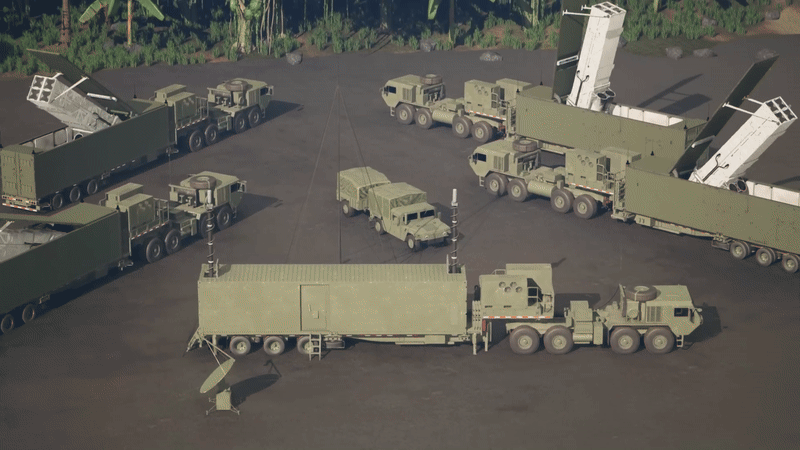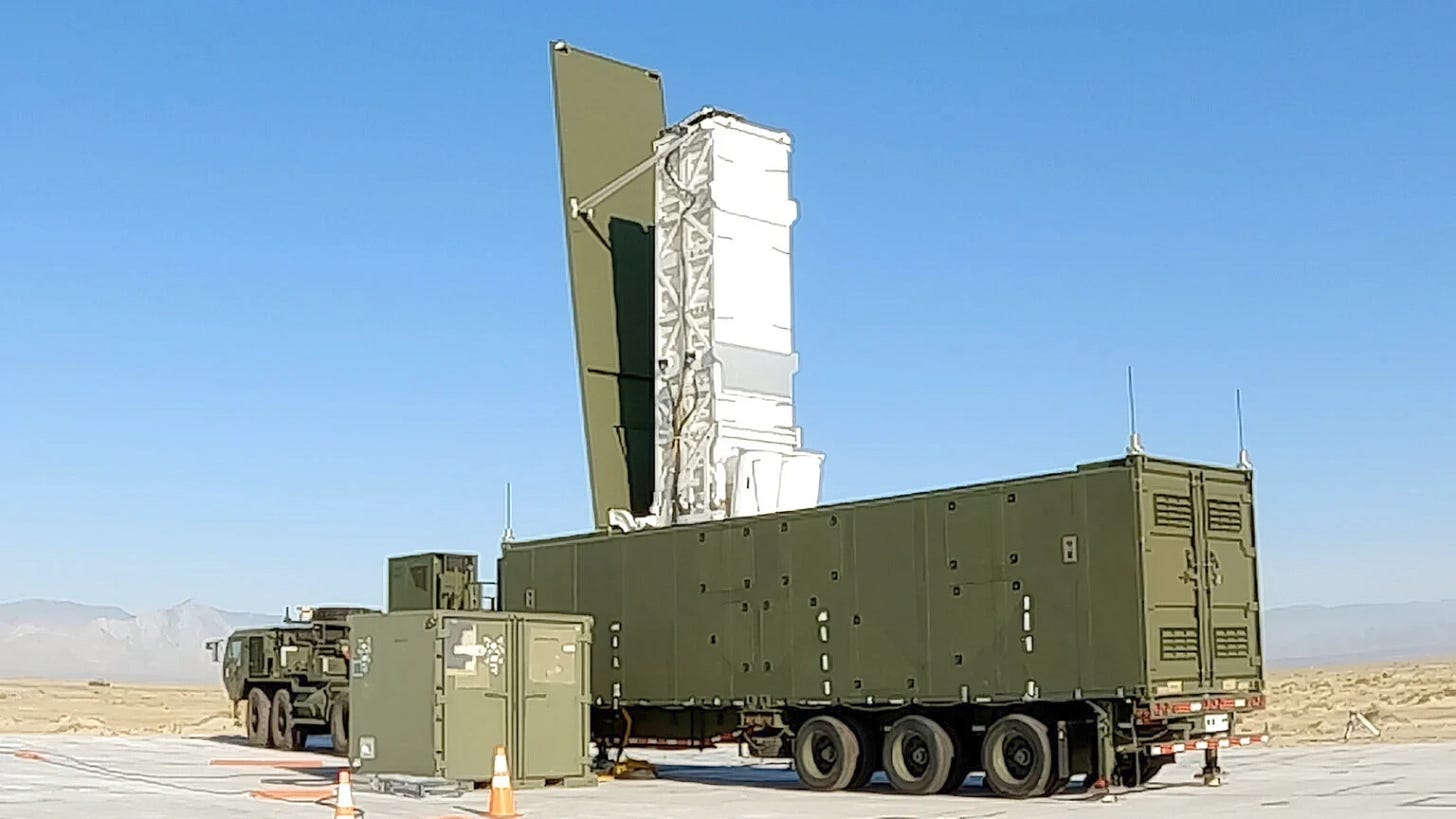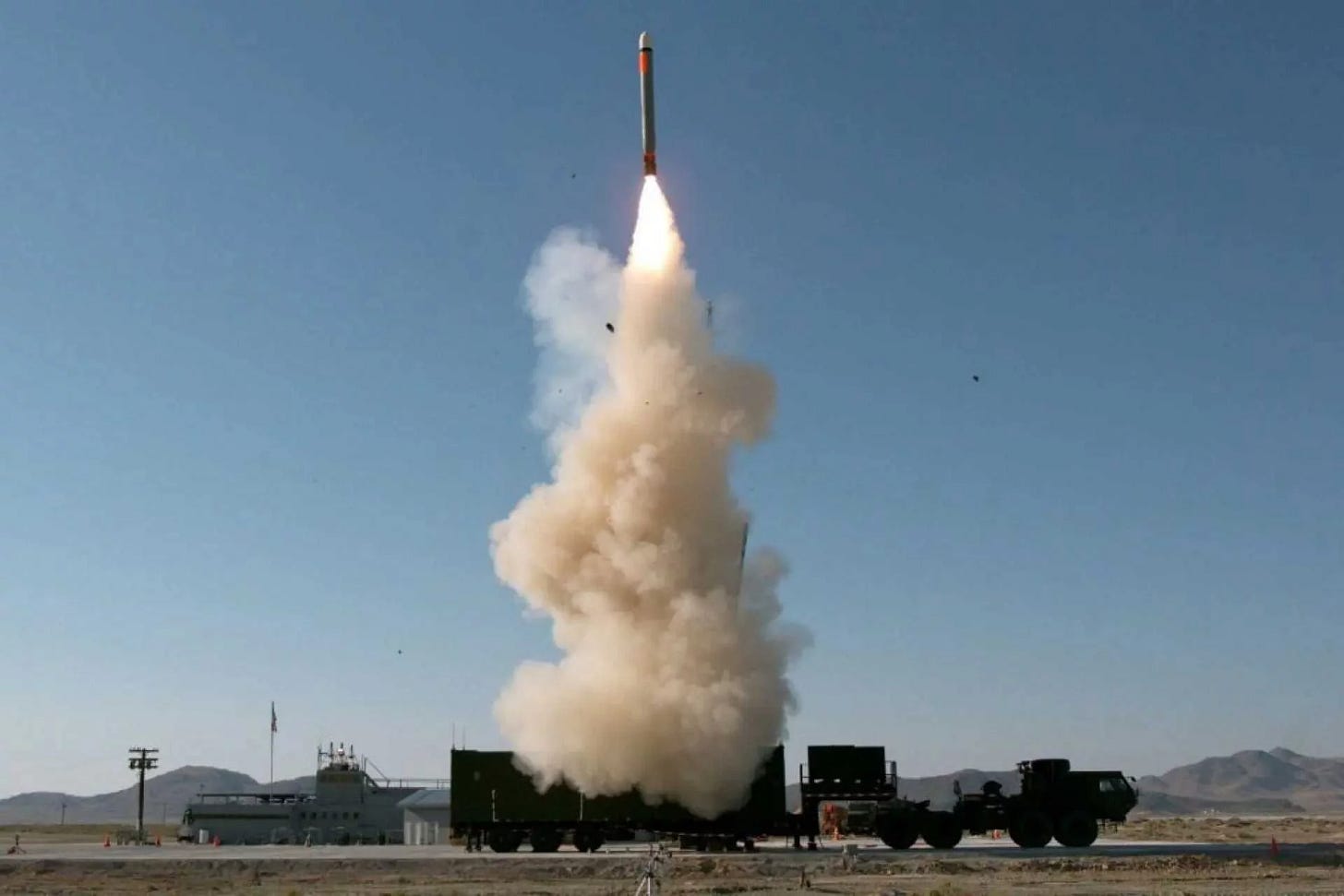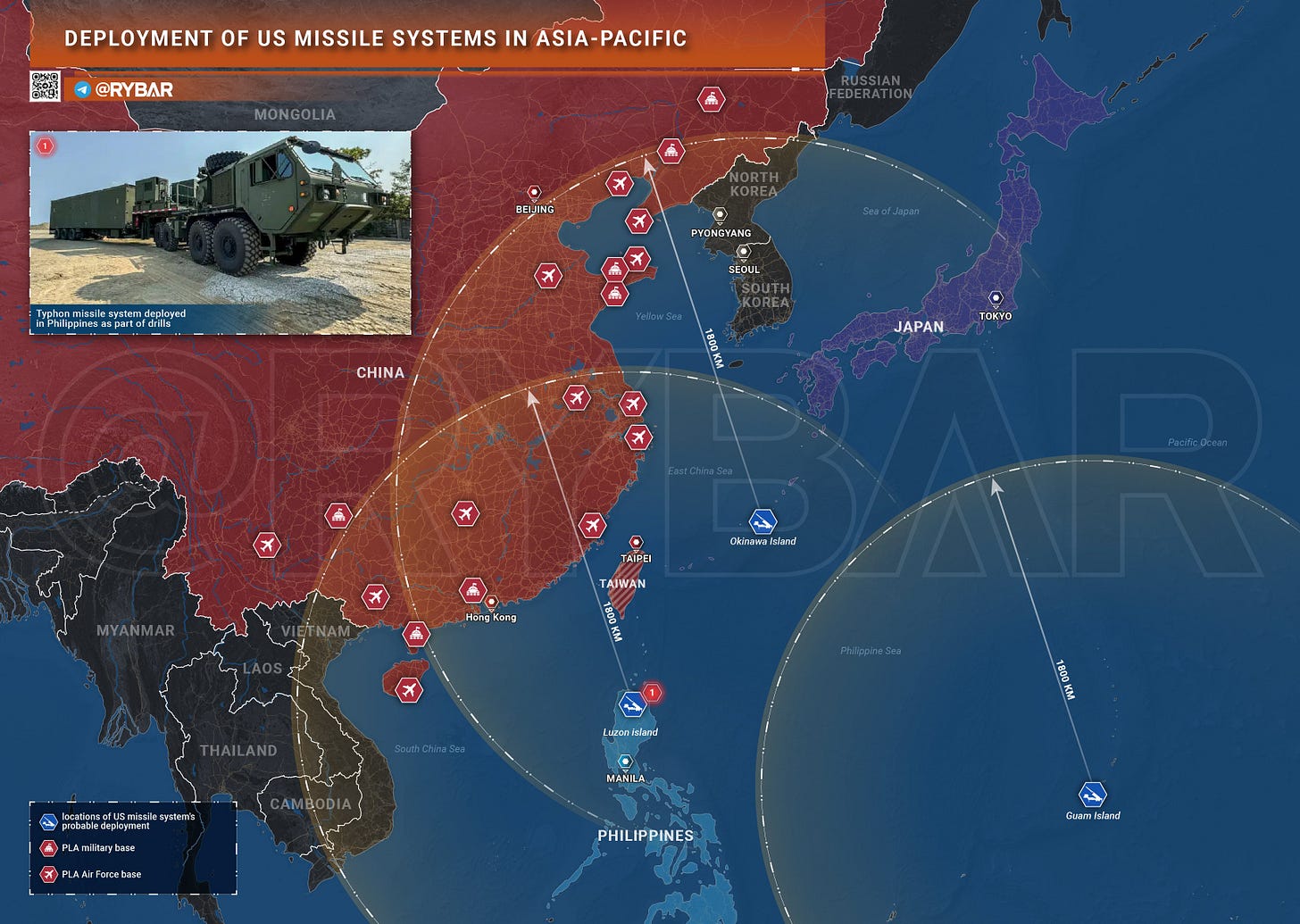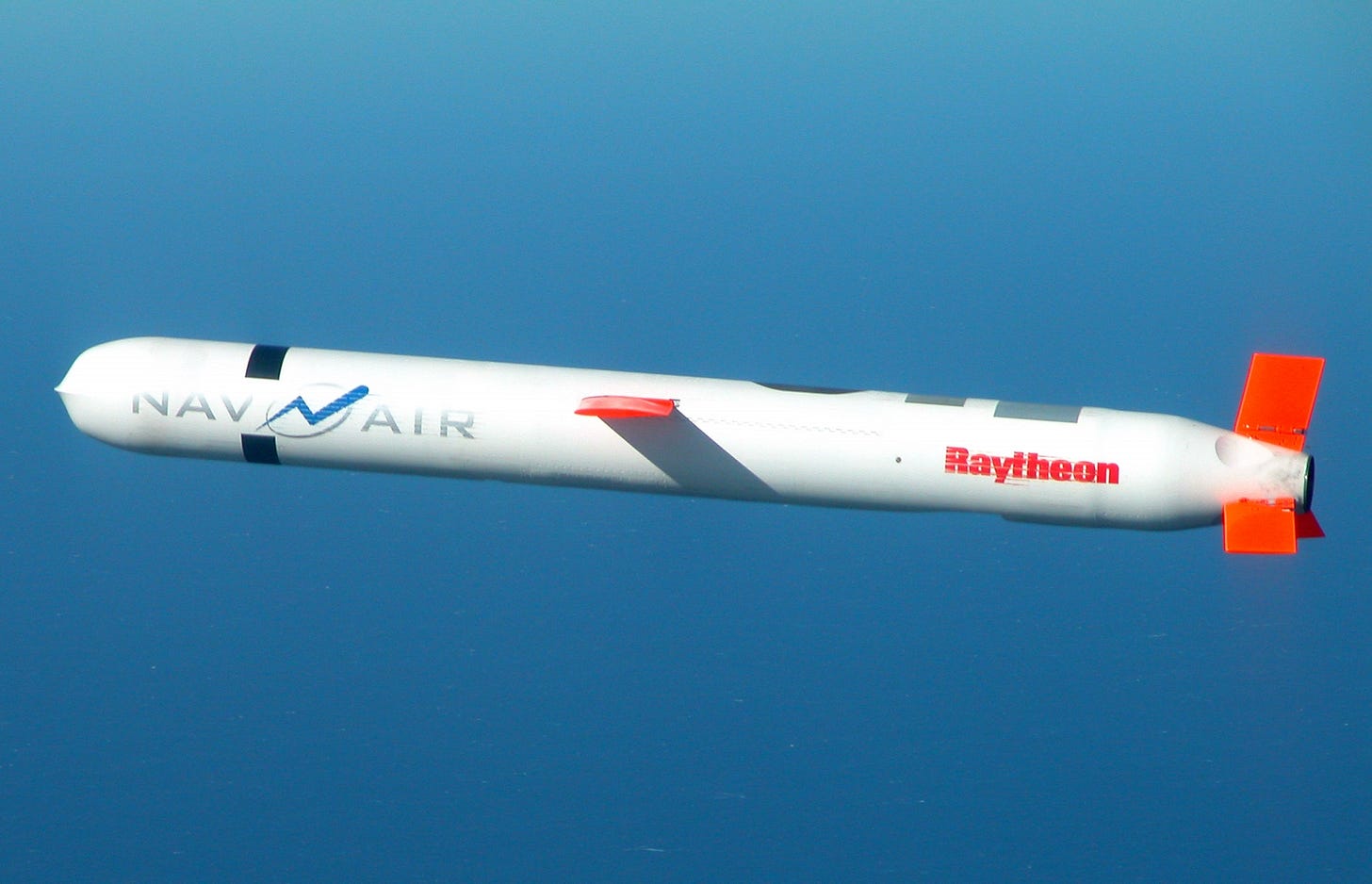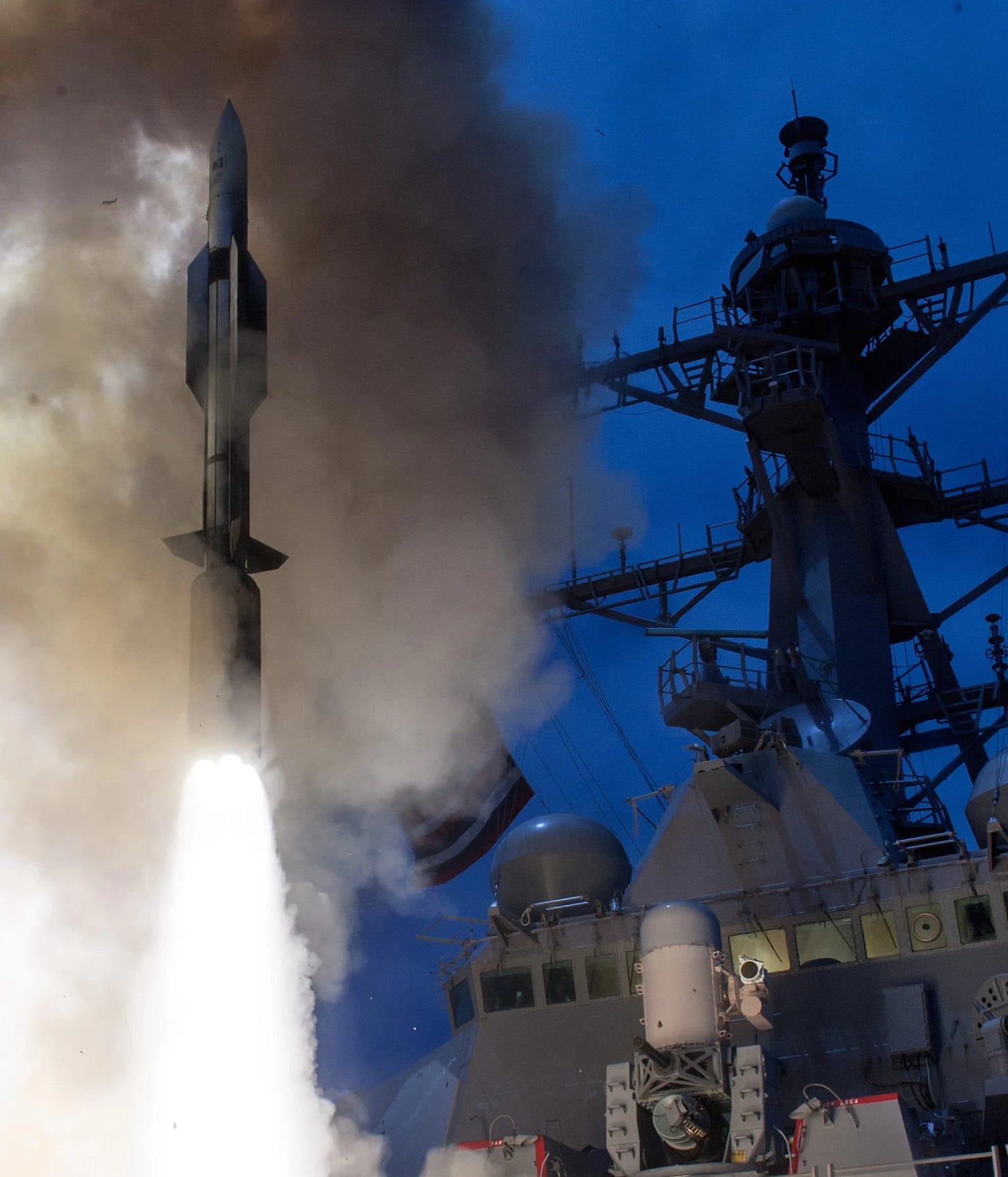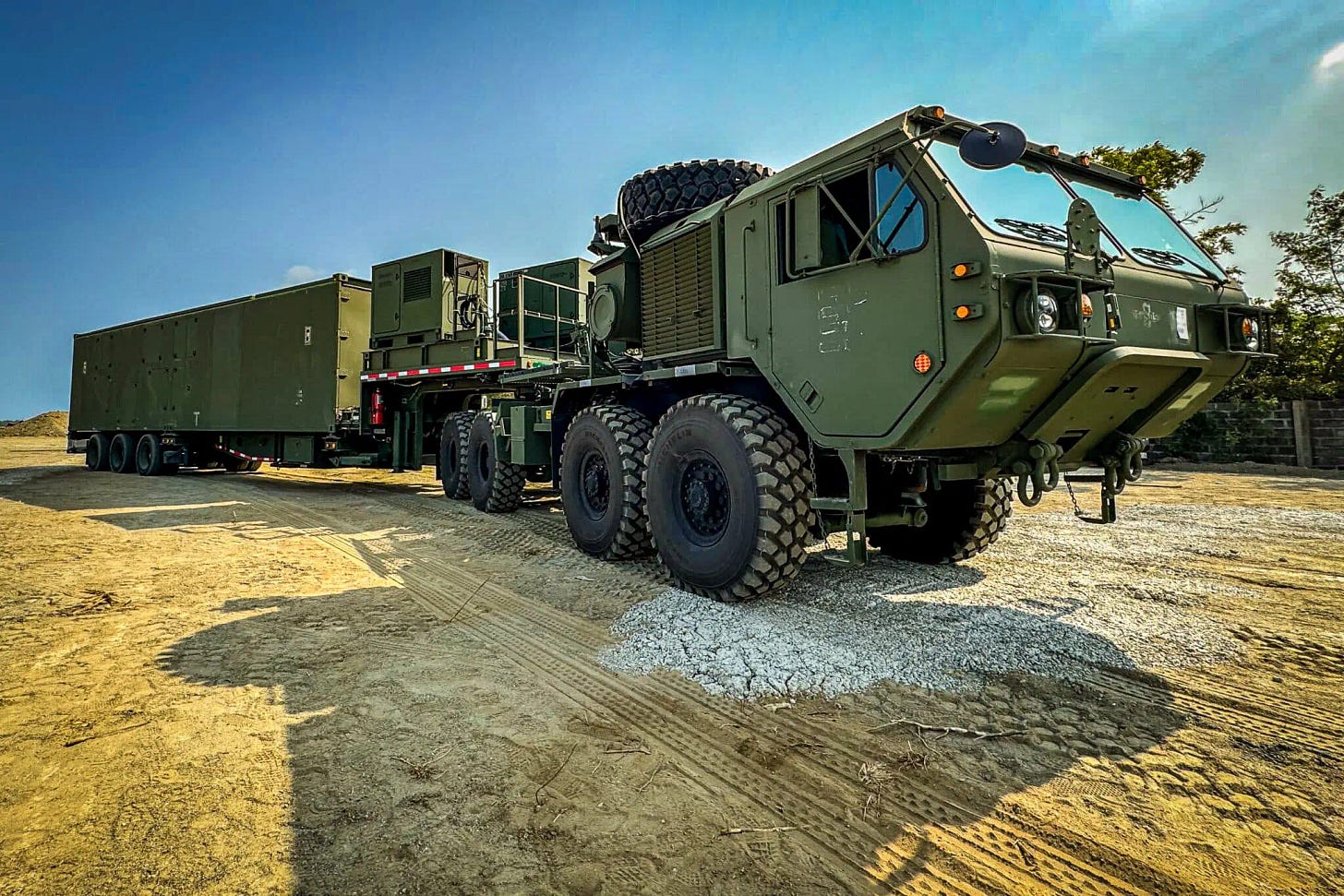This Missile System has China Worried.
The U.S. Typhon Missile System has been placed in the Philippines. A mobile, missile platform that uses SM-6 and Tomahawk missiles, Typhon allows the U.S. to strike targets in mainland China.
The Engineer's Perspective is a reader-supported publication. Sign and up and subscribe to see more in-depth Aerospace/Aeronautical Analysis!
Introduction and Overview:
The Strategic Mid-range Fires System (SMRF), also known as “Typhon” is a land-based strike weapon designed to enhance the U.S. Army's medium-range offensive capabilities. It does this by integrating the Navy’s Standard Missile-6 (SM-6) and the Tomahawk cruise missile, allowing the system to targeting both air and ground assets at greater ranges than previous systems. This system improves the U.S. Army’s ability to respond to threats at extended distances and offers flexibility through its ability to engage various target types.
At the core of the Typhon missile system is a mobile launch platform called the Heavy Expanded Mobility Tactical Truck (HEMTT). The system enables rapid deployment and flexibility, and when combined with the aforementioned Tomahawk and SM-6 missiles, allows to perform in a range of operational scenarios - including both air defense and precision land strikes. Essentially, the Typhon missile system represents a shift towards greater mobility and operational flexibility in military operations.
The development and deployment of the Typhon missile system are part of a broader shift in U.S. military strategy, particularly in the Indo-Pacific region. With growing regional security concerns, especially from China, the U.S. has focused on strengthening its strike capabilities by extending its range and flexibility. The Typhon missile system contributes to this effort by providing a mobile, long-range strike platform that can operate effectively in regions where traditional military infrastructure might be vulnerable or unavailable.
This deployment of the Typhon missile system in the region has implications for China. With its ongoing military modernization and territorial claims in the South China Sea, China has become a key focus of U.S. military strategy, of which the Typhon is one of the results. Typhon’s ability to target key military and economic infrastructure within the region could influence Chinese military planning and strategy. In this way, the Typhon missile system is a component of broader U.S. efforts to maintain a presence and influence in the region.
While the Typhon missile system is an important development in the U.S. military’s capabilities - offering extended strike range, flexibility, and mobility, it may also lead to strategic adjustments by other regional powers and influence the security landscape in the Indo-Pacific. In response to the system, China may seek to enhance its own military capabilities, potentially focusing on countermeasures or reinforcing its defensive infrastructure. The deployment of Typhon missiles could contribute to the strategic dynamics in the Indo-Pacific, influencing how both the U.S. and China approach regional security.
Historical Development:
The Typhon Missile System was developed as part of the U.S. Army's effort to address the growing need for medium-range, flexible strike capabilities. Its inception was driven by the military's recognition of evolving threats in regions such as the Indo-Pacific, where adversaries are increasingly employing advanced anti-access/area-denial (A2/AD) strategies to challenge U.S. and allied forces' freedom of movement.
Early Conceptualization and Design
The initial concept for the Typhon system focused on repurposing existing missile technologies from the U.S. Navy for land-based operations. Specifically, it sought to integrate the Tomahawk cruise missile, known for its long-range precision strike capabilities, and the Standard Missile 6 (SM-6), a versatile missile capable of engaging air, surface, and even ballistic missile targets. By adapting these proven systems to a mobile, ground-launched platform, the Army could rapidly develop a cost-effective solution without starting from scratch.
The design, by utilizing well known and established systems, could quickly transition to prioritize mobility and modularity, so that the system could be deployed quickly in diverse environments. The Typhon launchers are mounted on trailers, making them easy to transport and set up in forward-operating areas - an approach that allows for seamless integration with existing Army command-and-control systems.
Testing and Prototyping
The first operational prototypes of the Typhon system underwent rigorous testing in 2023. These tests validated the system's ability to launch both Tomahawk and SM-6 missiles from a land-based platform with high accuracy and reliability. Engineers focused on ensuring compatibility between the missiles' naval origins and their new ground-based configuration, addressing challenges such as adapting launch mechanisms and optimizing targeting systems.
The successful tests marked a significant milestone in the program anddemonstrated the Typhon systems ability to deliver precision strikes at medium-to-long ranges while maintaining flexibility across different mission profiles.
Deployment Milestones
In 2024, Typhon systems achieved initial operational capability (IOC) and were deployed to the Philippines as part of joint military exercises with regional allies. This deployment represented a key step in integrating the system into real-world operations. The Philippines was chosen due to its strategic location near critical areas such as the South China Sea, where tensions over territorial disputes and freedom of navigation are ongoing.
During these exercises, Typhon systems were used to simulate various scenarios, including precision strikes on simulated enemy air defenses and naval assets. The deployment showcased not only the system's technical capabilities but also its potential to enhance interoperability with allied forces in the region.
Continued Development
Following its initial deployment, work has continued to refine and expand the capabilities of the Typhon system. Efforts included improving its mobility by enhancing its trailer-mounted design for faster deployment in rugged terrains. Engineers also focused on integrating advanced targeting systems that leverage real-time data from satellites, drones, and other reconnaissance platforms to improve accuracy.
Additionally, research is being explored at expanding missile options beyond Tomahawk and SM-6 to further increase versatility. For example, incorporating future hypersonic missiles or other next-generation munitions could allow Typhon to address an even broader range of mission profiles. These ongoing refinements ensure that Typhon remains a cutting-edge asset capable of meeting evolving operational requirements in dynamic environments.
Furthermore, there is research that is being performed to see if any aspects of the Typhon could be reduced in size, allowing for easier modularity and transportability.
Implications:
The introduction of the Typhon missile system has reshaped the strategic landscape in the Indo-Pacific region, bringing both defensive and offensive advantages to the United States and its allies while presenting challenges to adversaries like China.
Defensive Implications for U.S. Allies
The Typhon missile system enhances deterrence for U.S. allies such as Taiwan and the Philippines, who face increasing threats from regional powers. Its ability to strike high-value targets at extended ranges without entering enemy airspace provides these nations with a robust defensive capability. Specific benefits include:
Philippines: With the Typhon system deployed in Northern Luzon, its range covers much of the South China Sea, allowing the Philippines to better defend its territorial claims against actions by China. Philippine officials have cited the missile system as an important asset for bolstering national security amid ongoing maritime disputes. Additionally, Philippine troops have received training on operating and maintaining the system, further integrating it into their defense strategy.
Taiwan: While the system has not been positioned in Taiwan, the Typhon could potentially serve as a potential deterrent against Chinese military activity in the Taiwan Strait if placed in Taiwan. Its potential ability to target naval assets and infrastructure would strengthen Taiwan's defensive posture.
These deployment could potentially foster closer military cooperation between the U.S. and its allies, with joint exercises and training ensuring operational readiness. For example, during Salaknib 2024 drills, Philippine forces worked alongside U.S. personnel to integrate the Typhon system into their operations.
Offensive Implications for the U.S.
For the United States, the Typhon missile system provides greater flexibility in responding to complex threats in contested environments like the South China Sea and Taiwan Strait. Key offensive advantages include:
Precision Strikes: The Tomahawk cruise missile's range of up to 2,500 km allows the U.S. to target critical infrastructure deep within adversary territory, including command centers and military installations. This capability is particularly useful for neutralizing high-value targets without risking aircraft or personnel.
Naval Disruption: The SM-6 missile can engage enemy ships and aircraft, disrupting adversarial maritime operations and ensuring freedom of navigation in contested waters. This capability is vital for countering China's expanding naval presence in areas like the South China Sea.
The Typhon system also introduces mobility into offensive operations. Its trailer-mounted design allows rapid repositioning during conflicts, ensuring survivability and adaptability in dynamic environments. Recent redeployment exercises in Luzon tested this mobility, demonstrating how quickly the system can be repositioned to respond to emerging threats.
Challenges for Adversaries
The deployment of Typhon systems has drawn criticism from China, which views them as a threat to its military and economic infrastructure. With ranges covering parts of mainland China, artificial outposts in the South China Sea, and strategic naval routes, Beijing sees the system as an escalation that could impact regional stability. Chinese officials have expressed concerns about what they perceive as increased militarization in the region.
U.S. officials have defended Typhon's deployment as necessary for maintaining regional security and countering China's growing influence. The Philippines has also expressed interest in acquiring its own Typhon systems to further strengthen its external defenses. This development highlights how Typhon is influencing military dynamics and shaping defense partnerships across the Indo-Pacific region.
Specifications:
The Typhon Missile System is a highly versatile, mobile, and advanced weapon platform designed to provide medium-range strike capabilities. Below is an expanded overview of its key specifications:
Missile Types
Tomahawk Cruise Missiles: Known for their long-range precision strike capabilities, Tomahawk missiles are capable of engaging land-based and maritime targets. They are versatile and can carry either conventional or nuclear payloads depending on mission requirements.
Standard Missile 6 (SM-6): The SM-6 serves as a multi-role missile capable of air defense, ballistic missile defense, and surface strike missions. It is optimized for intercepting aerial threats and engaging naval targets.
Range
Tomahawk Missile: Offers an operational range of up to 2,000 km (1,243 miles), making it ideal for deep-strike missions.
SM-6 Missile: Has a range of approximately 200 km (124 miles) for air defense and missile interception, with some variants extending beyond this range for surface-to-surface operations.
Launch Platform
The Typhon system's launcher is mounted on a trailer towed by the M983A4 Heavy Expanded Mobility Tactical Truck (HEMTT). This platform provides mobility and operational flexibility, enabling rapid deployment across various terrains.
Each launcher consists of four vertical launch cells derived from the Mk 41 Vertical Launch System (VLS), allowing it to carry a mix of SM-6 and Tomahawk missiles. A full battery includes four launchers, enabling the simultaneous deployment of up to 16 missiles before reloading.
Mobility
The M983A4 HEMTT is an 8x8 heavy-duty vehicle designed for both road and off-road mobility. It has a top speed of 80–96 km/h (50–60 mph) on paved roads and excellent cross-country capabilities. With a fuel range of approximately 480 km (298 miles), the system can operate in remote areas for extended periods.
The system's modular design ensures that it can be transported by air (e.g., using C-17 Globemaster aircraft), sea, or land, making it suitable for rapid deployment in diverse operational environments.
Payload
Both missile systems are capable of carrying conventional or nuclear warheads:
Tomahawk: Typically equipped with either a high-explosive warhead or a nuclear payload.
SM-6: Utilizes high-explosive blast fragmentation warheads for air defense and anti-surface missions.
Deployment
The Typhon system has been designed with an emphasis on rapid deployment to support U.S. Army Multi-Domain Task Forces in contested regions like the Indo-Pacific.
It has already been deployed in Northern Luzon, Philippines, where its range covers key areas such as the South China Sea, Taiwan Strait, and parts of mainland China. This deployment highlights its ability to project power across vast distances while remaining mobile.
Size and Weight
SM-6 Missile:
Length: 5.9 m
Diameter: 30 cm
Wingspan: 1.1 m
Weight: Approximately 1,000 kg
Tomahawk Missile:
Length: 6.1 m
Diameter: 51 cm
Wingspan: 2.4 m
Weight: Approximately 1,300 kg
Guidance Systems
The Typhon Missile System employs advanced radar and targeting technologies to ensure precision against both stationary and moving targets. These systems leverage real-time data from satellites, drones, and other reconnaissance platforms, enabling effective engagement in complex operational environments. Below is a detailed breakdown of the guidance systems used by the two missile types integrated into the Typhon system: the Tomahawk cruise missile and the Standard Missile-6 (SM-6).
Guidance Systems for Tomahawk Missiles
The Tomahawk cruise missile is renowned for its long-range precision strike capabilities, enabled by its sophisticated guidance systems:
Inertial Navigation System (INS): The missile uses an INS during its midcourse phase to maintain its trajectory based on pre-programmed coordinates.
Global Positioning System (GPS): GPS updates are integrated with the INS to enhance accuracy, ensuring precise targeting even during long-range missions.
Terrain Contour Matching (TERCOM): This system compares the missile’s onboard map data with terrain features below to refine its flight path, allowing it to navigate low-altitude routes and avoid detection.
Digital Scene Matching Area Correlation (DSMAC): In the terminal phase, DSMAC uses optical sensors to match the target area with stored images, ensuring pinpoint accuracy for high-value targets.
These combined systems enable Tomahawk missiles to strike land-based or maritime targets with exceptional precision, even in heavily defended environments.
Guidance Systems for SM-6 Missiles
The SM-6 missile incorporates a multi-mode guidance system designed for versatility across various mission profiles:
Midcourse Guidance:
Inertial Navigation System (INS): Like the Tomahawk, the SM-6 uses INS during its midcourse phase for stable flight.
Aegis Weapon System (AWS) Updates: The missile receives midcourse updates via radars or other sensors connected through Link 16 communications. This ensures real-time adjustments based on evolving target data.
Terminal Guidance:
Active Radar Seeker: Derived from the Advanced Medium-Range Air-to-Air Missile (AMRAAM), this X-band seeker provides high-resolution targeting during the terminal phase. It enables over-the-horizon engagements by detecting and homing in on targets independently of shipboard radars.
Semi-Active Mode: For certain missions, the SM-6 can operate in semi-active mode, relying on shipboard illuminators to guide it toward its target.
Cooperative Engagement Capability (CEC):
The SM-6 leverages CEC networks to integrate data from off-board sensors such as satellites or airborne platforms. This capability allows it to engage distant targets effectively, even beyond the range of shipboard radars.
Adaptability in Electronic Warfare Environments
Both missile systems are designed to operate effectively in environments with heavy electronic countermeasures:
The Tomahawk’s TERCOM and DSMAC systems allow it to navigate and strike accurately without relying solely on GPS, making it resilient against GPS jamming.
The SM-6’s active radar seeker ensures autonomous targeting during its terminal phase, reducing dependence on external guidance systems susceptible to interference.
Integration with Typhon Launcher
The Typhon launcher is equipped with advanced radar systems that facilitate initial target acquisition and tracking. These systems work seamlessly with both missile types:
For Tomahawk missiles, the launcher provides initial targeting data based on reconnaissance inputs before handing off guidance responsibilities to the missile’s onboard systems.
For SM-6 missiles, the launcher integrates with AWS and CEC networks to provide midcourse updates while leveraging off-board sensors for extended-range engagements.
The combination of these guidance technologies makes the Typhon Missile System a formidable platform capable of delivering precision strikes against high-value targets in contested environments. Its ability to integrate advanced guidance systems ensures operational flexibility across diverse mission profiles.
Modularity and Future Upgrades
The Typhon Missile System's modular design is a key feature that ensures its adaptability to evolving military needs and technological advancements. This flexibility is achieved through its launcher architecture, which is derived from the Navy's Mk 41 Vertical Launch System (VLS):
Modular Launcher Design
The Typhon system's launcher is designed to accommodate a variety of missile types, making it inherently versatile. Each launcher consists of four missile cells, capable of housing different missiles such as the SM-6 and Tomahawk cruise missiles. This modularity allows commanders to tailor the payload to specific mission requirements.
The launcher's compatibility with the Mk 41 VLS technology ensures seamless integration with existing missile systems while allowing for future upgrades. For example, it can incorporate new missile types without requiring significant hardware modifications.
Future Integration of Advanced Missile Types
The modularity of the Typhon system positions it to integrate cutting-edge missile technologies as they become available:
Hypersonic Missiles:
The U.S. Army is actively developing hypersonic weapons capable of traveling at speeds exceeding Mach 5. Typhon's compatibility with Mk 41 VLS technology could potentially allow for these missiles to provide the Typhon system with expanded strike capabilities, enabling it to penetrate advanced air defense systems and engage time-sensitive targets at extreme ranges.
Next-Generation Anti-Ship Missiles:
The Tomahawk missile is already being upgraded with enhanced anti-ship capabilities, such as improved targeting systems and increased range. These advancements would make the Typhon system even more effective in maritime operations, particularly in contested regions like the South China Sea.
Future variants of anti-ship missiles could also be integrated, providing additional options for countering naval threats.
Advanced Air Defense Missiles:
The SM-6 missile, currently used for air defense and surface strike missions, may see further enhancements in range and targeting capabilities. This would allow the Typhon system to engage a broader spectrum of threats, including ballistic missiles and low-flying cruise missiles.
Upgrades to Command and Control Systems
In addition to integrating new missile types, the Typhon system's command and control (C2) infrastructure is designed for continuous improvement:
The system can incorporate advanced targeting algorithms powered by artificial intelligence (AI) to improve decision-making speed and accuracy.
Enhanced data-sharing capabilities with platforms like satellites, drones, and other reconnaissance assets will ensure real-time situational awareness for commanders.
Scalability and Portability
The U.S. Army is exploring ways to scale down the size of the Typhon system while maintaining its capabilities. A more compact version of the launcher would improve deployability and reduce logistical challenges, especially in austere environments or when operating alongside allied forces.
Operational Flexibility
The Typhon system's ability to deploy multiple missile types makes it a critical asset in modern military operations:
It bridges the gap between short-range tactical missiles and long-range strategic assets, providing commanders with a versatile tool for engaging targets at various distances.
Its modularity ensures that it remains relevant as new threats emerge and technology evolves.
The Typhon Missile System's modular design allows it to integrate future technologies like hypersonic weapons and next-generation anti-ship missiles, and represents a significant advancement in medium-range strike capabilities by combining mobility, precision, and versatility.
Concept of Operations:
The Typhon missile system is designed to provide rapid deployment, flexibility, and precision in medium-range strike missions. The below concept of operations (CONOPS) framework is to give an idea of how Typhon can effectively engage high-value targets while supporting both offensive and defensive strategies. Below is an expanded breakdown of its concept of operations:
Stakeholders
The Typhon system serves a diverse range of stakeholders:
U.S. Military Forces: The primary operators, including the Army’s Multi-Domain Task Forces, which integrate land, sea, air, cyber, and space capabilities.
Strategic Planners: Responsible for incorporating the Typhon system into broader military strategies, particularly in contested regions like the Indo-Pacific.
Defense Contractors: Lockheed Martin and Raytheon are key contributors to the system’s development and maintenance.
Allied Forces: Countries such as the Philippines benefit from joint training exercises and potential acquisition of the system to bolster their own defense capabilities.
Purpose
The Typhon missile system fills a critical gap in U.S. Army capabilities by providing a land-based platform for engaging air, ground, and maritime targets at extended ranges. It complements other systems like the Precision Strike Missile (shorter range) and Long-Range Hypersonic Weapon (longer range), offering medium-range precision strike capabilities. This enhances deterrence and offensive options in regions where access to airspace is contested.
Operational Overview
Pre-Launch Operations:
Deployment: The Typhon system is mounted on M983A4 Heavy Expanded Mobility Tactical Trucks (HEMTT) for transportability, and can be deployed via airlift (e.g., C-17 Globemaster aircraft) or maritime transport to strategic locations.
Integration: Once deployed, the system integrates with reconnaissance platforms such as satellites, drones, and ground-based radars to receive targeting data.
Preparation: Crews conduct pre-launch checks, including missile loading, targeting calibration, and communication setup with command centers.
Launch Operations:
Precision Strikes: The system launches missiles with high accuracy using advanced guidance systems. The Tomahawk cruise missile utilizes GPS, TERCOM, and DSMAC for long-range precision targeting, while the SM-6 employs active radar seekers for dynamic engagements.
Mission Profiles:
Preemptive strikes against enemy air defenses or command centers in anti-access/area-denial (A2/AD) environments.
Retaliatory strikes on high-value targets following hostile actions.
Maritime operations targeting enemy ships or artificial outposts.
Post-Launch Operations:
Data Analysis: After missile engagement, telemetry data is analyzed to assess mission effectiveness and refine tactics.
Reloading and Maintenance: Launchers are reloaded with missiles as needed, ensuring readiness for subsequent missions. Crews perform routine maintenance to maintain operational reliability.
Key Capabilities
The Typhon system offers several critical capabilities:
Extended Strike Range:
Tomahawk missiles provide a range of up to 2,000 km (1,240 miles), enabling deep-strike missions against land-based or maritime targets.
SM-6 missiles offer a range of approximately 200 km (124 miles), optimized for air defense and surface strike missions.
Mobile Deployment:
Mounted on HEMTT trucks, the system can traverse diverse terrains and reposition quickly during operations.
Its modular design allows transport via air or sea for deployment in remote or contested areas.
Flexible Missile Options:
The ability to launch both Tomahawk cruise missiles and SM-6 interceptors ensures versatility across mission types.
Future upgrades may include hypersonic weapons or enhanced anti-ship variants of existing missiles.
Interoperability:
The Typhon integrates seamlessly into multi-domain frameworks, leveraging real-time data from reconnaissance platforms like satellites and drones.
Deployment Examples
The Typhon system has already demonstrated its operational flexibility through deployments in the Indo-Pacific region:
In early 2024, it was stationed in Northern Luzon during joint military exercises such as Salaknib 2024 between U.S. and Philippine forces. This deployment showcased its ability to cover strategic areas like the South China Sea and Taiwan Strait
The U.S. Army validated its maritime transport capability by loading the system onto civilian vessels during exercises at the Port of Tacoma. This test highlighted its adaptability for coastal operations.
Strategic Role
The Typhon missile system plays a vital role in countering A2/AD threats by enabling precision strikes on high-value targets such as air defense systems, missile launchers, command centers, and naval assets. Its ability to operate effectively in heavily defended environments makes it a critical asset for enhancing regional security and maintaining freedom of navigation.
By combining mobility, precision targeting, and flexibility across multiple domains, the Typhon missile system represents a significant advancement in modern military operations. Its concept of operations ensures that it remains adaptable to evolving threats while supporting U.S. strategic objectives globally.
Systems Engineering:
The Typhon Missile System represents a sophisticated engineering achievement designed to address the U.S. Army's need for a flexible, mobile, and effective medium-range strike capability. Its systems engineering incorporates cutting-edge technologies and design principles to ensure adaptability, survivability, and precision in diverse operational environments. Below is an expanded breakdown of its systems engineering components:
System Objectives
The primary goal of the Typhon system is to provide the U.S. Army with a land-based missile platform capable of engaging high-value targets at medium ranges. This includes:
Countering Regional Threats: The system is optimized for operations in contested environments, such as anti-access/area-denial (A2/AD) zones, where adversaries employ advanced missile defense systems and layered air defenses.
Enhancing Operational Flexibility: The Typhon system bridges the gap between short-range tactical missiles and long-range strategic assets, offering commanders versatility across a range of mission profiles.
Supporting Multi-Domain Operations: The system integrates seamlessly into the Army's Multi-Domain Task Forces, leveraging real-time data from air, sea, space, and cyber domains.
Operating Conditions
The Typhon system is designed to function effectively in diverse environmental conditions:
Hot Desert Environments: Its rugged construction ensures reliable performance in high temperatures and sandy terrains.
Coastal Regions: The system’s corrosion-resistant materials and modular design allow deployment in humid and salty coastal environments.
Cold Climates: It can operate in freezing temperatures, ensuring functionality in Arctic or mountainous regions.
This adaptability makes the Typhon system suitable for global deployment, including regions like the Indo-Pacific, Europe, and the Middle East.
Expected Challenges
While the Typhon system is highly capable, several challenges must be addressed to maximize its operational effectiveness:
Missile Defense Countermeasures:
Adversaries may deploy electronic warfare (EW) systems to jam GPS signals or disrupt communication links.
Advanced missile defense systems could intercept incoming missiles before they reach their targets.
Solutions: The Typhon system incorporates resilient guidance technologies such as TERCOM (Terrain Contour Matching) and DSMAC (Digital Scene Matching Area Correlation) for Tomahawk missiles, as well as active radar seekers for SM-6 missiles to mitigate these threats.
Rapid Logistics:
Ensuring timely resupply of missiles and maintenance of launchers during extended operations poses logistical challenges.
Solutions: Modular launcher designs allow for quick reloading, while integration with existing logistics networks ensures efficient resupply chains.
Operational Coordination:
Coordinating multi-domain operations requires seamless communication between various platforms (e.g., satellites, drones, ground-based radars).
Solutions: The system leverages advanced command-and-control frameworks like Cooperative Engagement Capability (CEC) to facilitate real-time data sharing.
Design Considerations
The Typhon system is engineered with scalability and interoperability as core principles:
Scalability:
The launcher’s modular design allows integration of future missile technologies without significant hardware modifications.
Potential upgrades include hypersonic weapons or enhanced variants of existing missiles like Tomahawk Block V or SM-6 Extended Range.
Interoperability:
The system uses components derived from the Navy’s Mk 41 Vertical Launch System (VLS), ensuring compatibility with allied forces’ platforms.
It integrates seamlessly into multi-domain frameworks by leveraging data from reconnaissance assets such as satellites, drones, and naval radars.
Mobility and Survivability
The Typhon system emphasizes mobility to enhance survivability in high-threat environments:
Mounted on M983A4 Heavy Expanded Mobility Tactical Trucks (HEMTT), it can rapidly reposition across diverse terrains to avoid detection or targeting by adversaries.
Recent redeployment exercises in Luzon demonstrated its ability to quickly shift firing positions during simulated conflicts, ensuring operational readiness.
Integration with Multi-Domain Operations
The Typhon system plays a critical role in supporting multi-domain operations:
It connects with advanced reconnaissance platforms like satellites and drones to receive real-time targeting data.
Its compatibility with Cooperative Engagement Capability (CEC) networks allows it to engage targets beyond the range of onboard sensors.
Future Evolution
As part of the U.S. Army’s Long-Range Precision Fires modernization portfolio, the Typhon system is expected to evolve further:
Integration of hypersonic glide vehicles or next-generation cruise missiles will enhance its strike capabilities against heavily defended targets.
Upgrades to command-and-control systems may incorporate artificial intelligence (AI) for faster decision-making and improved accuracy.
By addressing these engineering considerations and challenges, the Typhon Missile System remains a vital asset for modern military operations. Its adaptability ensures that it can meet evolving threats while maintaining operational superiority across diverse mission scenarios.
Systems Engineering Requirements:
The Typhon Missile System's design is guided by a comprehensive set of systems engineering requirements that ensure its operational effectiveness, adaptability, and resilience in diverse environments. Below is an expanded breakdown of the functional, physical, environmental, and interface requirements:
Functional Requirements
The Typhon system is engineered to meet critical operational needs, focusing on flexibility and precision:
Missile Compatibility:
The system must launch both Tomahawk cruise missiles and SM-6 interceptors seamlessly. This dual capability ensures versatility across mission profiles, including long-range precision strikes and air defense.
The launcher’s modular design accommodates future missile types, such as hypersonic weapons or enhanced anti-ship variants of the Tomahawk missile.
Operational Range:
The system must achieve a minimum operational range of 2,000 km for Tomahawk missiles to engage high-value targets deep within adversary territory.
SM-6 missiles must provide a range of approximately 200 km for air defense and surface strike missions.
Mobility:
Mounted on M983A4 Heavy Expanded Mobility Tactical Trucks (HEMTT), the system must ensure rapid deployment and repositioning in contested or remote areas.
The launcher must be capable of being transported by air (e.g., C-17 Globemaster aircraft), sea, or land for deployment in diverse theaters.
Physical Requirements
The physical design of the Typhon system emphasizes durability, rapid deployment, and operational readiness:
Deployment Time:
The system shall be deployable within 24 hours of notification. This includes transportation to the designated location, setup of launchers, and integration with command-and-control systems.
Durability:
The system shall withstand harsh environmental conditions, including extreme temperatures (-40°C to +60°C) and high humidity levels common in tropical or desert climates.
Materials used in the launcher and truck components must be resistant to wear and corrosion, particularly for operations in coastal or maritime environments.
Structural Integrity:
The launcher’s design must ensure stability during transport and missile launches, even in rugged terrains or adverse weather conditions.
Environmental Requirements
The Typhon system is designed to operate effectively in diverse environmental conditions worldwide:
Temperature Resilience:
The system shall operate reliably in temperatures ranging from -40°C to +60°C, ensuring functionality in Arctic regions, deserts, and tropical climates.
Saltwater Resistance:
For maritime deployments near coastal regions or aboard ships, the system shall be resistant to saltwater corrosion through the use of specialized coatings and materials.
Shock and Vibration Tolerance:
The launcher must endure mechanical shocks and vibrations during transport over rough terrain or when subjected to nearby explosions.
Interface Requirements
To ensure seamless integration into broader military operations, the Typhon system incorporates advanced interface capabilities:
Command-and-Control Integration:
The system shall integrate with existing military command-and-control frameworks, such as Cooperative Engagement Capability (CEC) networks. This allows real-time data sharing with satellites, drones, ground-based radars, and naval assets.
Interoperability:
The launcher shall be compatible with multi-domain systems used by allied forces to enhance joint operations during coalition missions.
Data Processing:
The system shall process targeting data from reconnaissance platforms (e.g., satellites or unmanned aerial vehicles) to enable precision strikes against stationary or moving targets.
Additional Considerations
Scalability:
The modular design ensures scalability for future upgrades without significant hardware modifications. This includes integrating next-generation missile technologies such as hypersonic weapons or advanced anti-ship missiles.
Logistical Support:
Maintenance requirements shall be minimized through the use of durable materials and self-diagnostic systems that identify faults quickly.
Electronic Warfare Resilience:
Guidance systems for both Tomahawk and SM-6 missiles must be resilient against electronic countermeasures (e.g., GPS jamming). This is achieved through technologies like TERCOM (Terrain Contour Matching) for Tomahawk missiles and active radar seekers for SM-6 missiles.
The Typhon Missile System's engineering requirements reflect its role as a versatile and adaptable weapon platform capable of addressing modern military challenges across diverse operational environments. By meeting these stringent criteria, the system ensures its effectiveness in enhancing U.S. Army capabilities while remaining flexible for future advancements.
Conclusion:
The Typhon missile system represents a significant leap forward in U.S. military technology, offering a highly mobile, flexible, and extended-range strike capability that aligns with modern defense strategies. Designed to fill the gap between short-range tactical systems like the Precision Strike Missile (PrSM) and long-range hypersonic weapons, Typhon provides a critical mid-range capability for addressing emerging threats in contested environments.
The system’s ability to launch both Tomahawk cruise missiles and SM-6 interceptors ensures versatility across a broad spectrum of mission profiles, from precision strikes on high-value land targets to maritime operations targeting enemy ships. Its modular design allows for future upgrades, including the integration of hypersonic weapons or enhanced anti-ship variants, ensuring its relevance as military needs evolve.
As the geopolitical landscape continues to shift, particularly in high-stakes regions such as the Indo-Pacific, the Typhon system plays a vital role in countering anti-access/area-denial (A2/AD) strategies employed by adversaries like China. Its deployment within Multi-Domain Task Forces (MDTFs) demonstrates its strategic importance in synchronizing precision fires and effects across land, sea, air, space, and cyber domains. With three of the five planned MDTFs dedicated to the Pacific theater, Typhon is positioned as a cornerstone of U.S. deterrence and power projection in the region.
The rapid development and deployment of Typhon—fielded in less than three years—highlight the U.S. Army’s commitment to maintaining technological superiority. Its first operational battery was deployed in 2024 during joint exercises in the Philippines, showcasing its ability to integrate with allied forces and operate effectively across diverse environments. Future deployments, such as planned tests in Australia during the Talisman Sabre exercise, further demonstrate its adaptability and global reach.
In conclusion, the Typhon missile system embodies the principles of modern warfare: mobility, precision, adaptability, and interoperability. As part of the U.S. Army’s Long-Range Precision Fires modernization portfolio, it ensures that commanders have a versatile tool for engaging a wide range of threats while maintaining strategic flexibility. Whether deployed for deterrence or combat operations, Typhon will remain a critical component of U.S. military capabilities for years to come.
References:
Firstpost. (n.d.). The US Typhon missile system in the Philippines that has alarmed China - all you need to know. Firstpost. firstpost.com/explainers/us-typhon-missile-system-philippines-south-china-sea-defence-tensions-13874760.html (Note: Exact publication date may be needed)
ArmyRecognition.com. (n.d.). Redeployment of Typhon Missiles in Philippines: US Strategy and Geopolitical Implications. ArmyRecognition.com. https://www.armyrecognition.com/focus-analysis-conflicts/army/analysis-defense-and-security-industry/redeployment-of-typhon-missiles-in-philippines-us-strategy-and-geopolitical-implications (Note: Exact publication date may be needed)
Press Xpress. (2025, January 23). US Missile Deployment in Luzon: Balancing Power or Fueling Regional Tensions. Press Xpress. https://pressxpress.org/2025/01/23/us-missile-deployment-in-luzon-balancing-power-or-fueling-tensions/
USNI News. (2025, March 28). Report to Congress on U.S. Army's Typhon Strategic Mid-Range Fires System. USNI News. https://news.usni.org/2025/03/28/report-to-congress-on-u-s-armys-typhon-strategic-mid-range-fires-system
The Diplomat. (2024, December). Philippines Defends Plan to Acquire Typhon Missile System From US. The Diplomat. https://thediplomat.com/2024/12/philippines-defends-plan-to-acquire-typhon-missile-system-from-us/ (Note: Could use the more specific publication date if available).
SCMP. (2025, March 24). US will not 'live fire' Philippines-based Typhon missile system that .... SCMP. https://www.scmp.com/news/china/military/article/3303683/us-will-not-live-fire-philippines-based-typhon-missile-system-angered-china (Note: Exact publication date may be needed)
The Defense Post. (2025, February 24). China's New Submarine Could Target Typhon Missiles in Philippines. The Defense Post. https://thedefensepost.com/2025/02/24/china-submarine-typhon-missiles/
The U.S. Missile Launcher That Is Enraging China. (2025, March 25). WSJ. https://www.wsj.com/world/asia/china-us-typhon-weapons-system-missile-philippines-100fd852?mod=Searchresults_pos5&page=1 (Note: Exact publication date and author may be needed)
Larter, D. (2025, March 20). US Army will not conduct Typhon live-fire at exercises in Philippines. Defense News. https://www.defensenews.com/land/2025/03/21/us-army-will-not-conduct-typhon-live-fire-at-exercises-in-philippines/
China-US Focus. (n.d.). Typhon Missile: A Game Changer in Philippine-China-US Strategic .... China-US Focus. https://chinausfocus.com/foreign-policy/typhon-missile-a-game-changer-in-philippine-china-us-strategic-triangle (Note: Exact publication date may be needed)
US Military Praises Missile Deployment Against China - Newsweek. (n.d.). Newsweek. https://www.newsweek.com/us-news-army-mrc-typhon-deployment-philippines-china-2046569 (Note: Exact publication date and author may be needed)
Congressional Research Service. (2025, March 27). The U.S. Army’s Typhon Strategic Mid-Range Fires System. USNI News. https://news.usni.org/2025/03/28/report-to-congress-on-u-s-armys-typhon-strategic-mid-range-fires-system (Note: The report itself is by the Congressional Research Service)
Callahan, J. (n.d.). journal of advanced military studies. Marine Corps University. https://usmcu.edu/Portals/218/JAMS/jams-15-2-callahan.pdf (Note: Need exact date, volume, and issue number for journal. Author listed based on filename.)
ArmyRecognition.com. (n.d.). Flash News: Following Philippines Deployment US Army to Field New Typhon Missile System in Europe in 2026. ArmyRecognition.com. https://www.armyrecognition.com/news/army-news/2025/flash-news-following-philippine-deployment-us-army-to-field-new-typhon-missile-system-in-europe-in-2026 (Note: Exact publication date may be needed)
Larter, D. (2025, March 19). US Army readies second Typhon battery for Pacific deployment. Defense News. https://www.defensenews.com/land/2025/03/17/us-army-readies-second-typhon-battery-for-pacific-deployment/
USNI News. (2015, May 26). Essay: Changing the Anti-Ship Cruise Missile Paradigm. USNI News. https://news.usni.org/2015/05/26/essay-changing-the-anti-ship-cruise-missile-paradigm
Atlantic Council. (2023, November 25). Ten challenges to implementing Force Design 2030. https://atlanticcouncil.org/in-depth-research-reports/report/ten-challenges-to-implementing-force-design-2030/
The Engineer's Perspective is a reader-supported publication. To receive new posts and support my work, consider becoming a free or paid subscriber.



